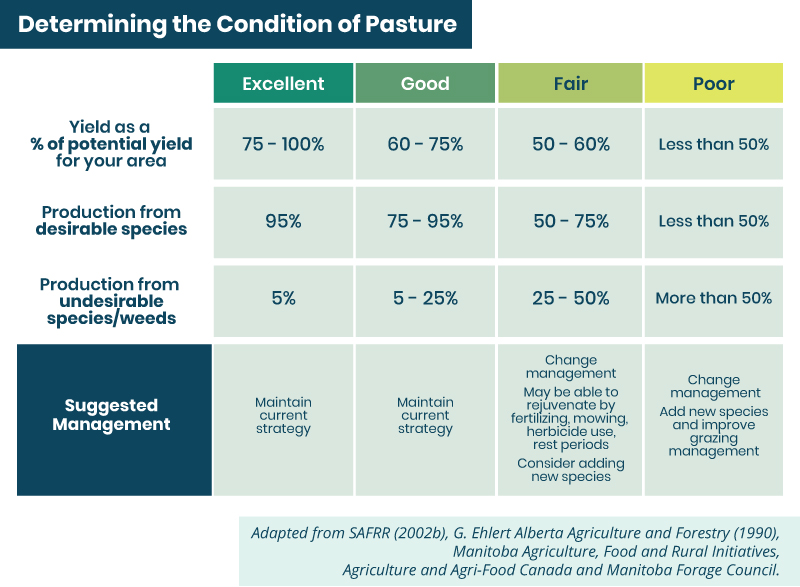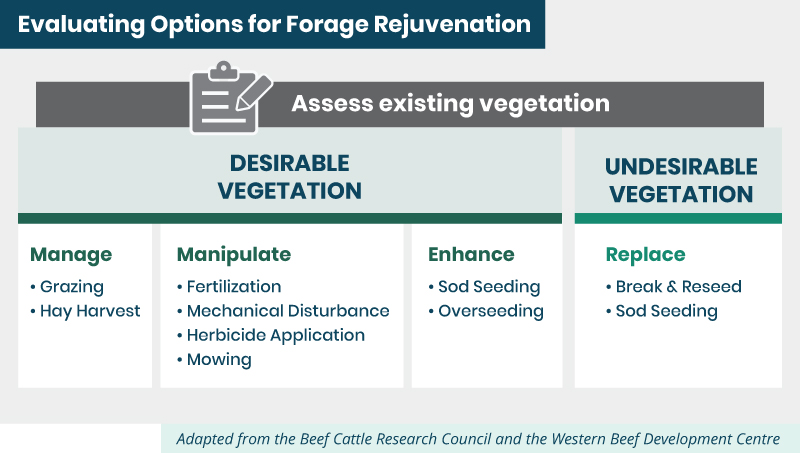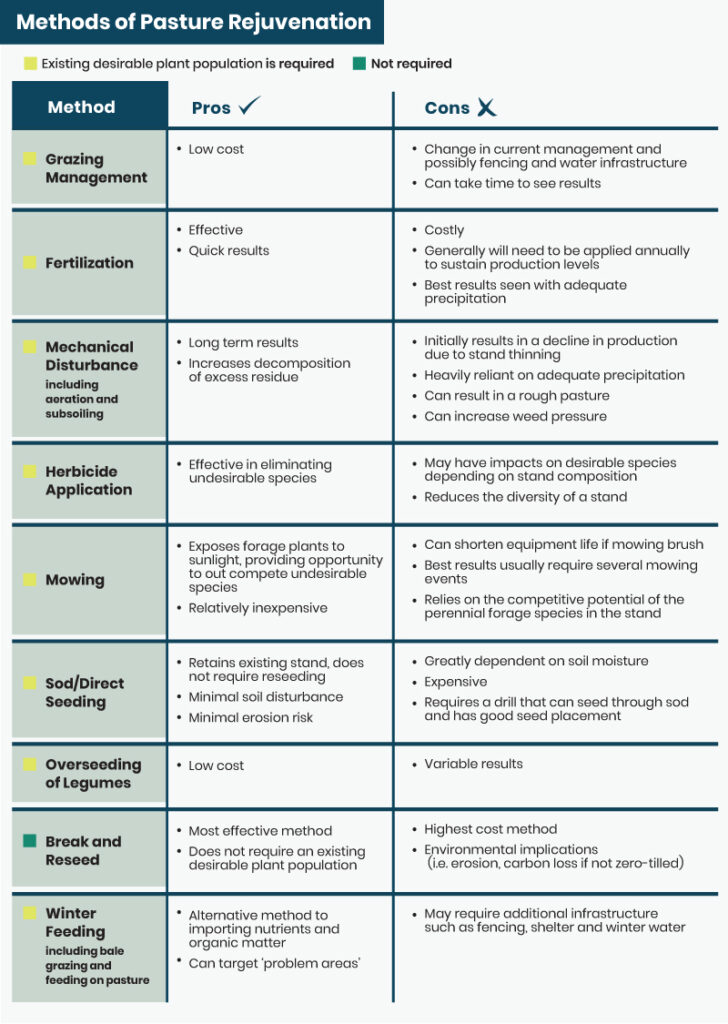Rejuvenating Tame Pastures
On This Page
ASSESSING THE NEED FOR PASTURE REJUVENATION
METHODS OF PASTURE REJUVENATION
This module will help you assess the need for pasture rejuvenation, and if it is required, what method(s) may best suit your operation.
Assessing the Need for Pasture Rejuvenation
Key Points:
- The first step in pasture rejuvenation is to assess the reason for declining forage productivity or a lack of desirable forage species in the pasture.
- If overgrazing is the underlying reason for a decline in pasture productivity or has caused a shift in plant species composition, this should be addressed through management before rejuvenating the stand, otherwise the full benefits of rejuvenation may not be realized.
- Determine the goal of rejuvenation.
- Assess current moisture conditions.
Use the Rejuvenating a Forage Stand and Establishing a Forage Stand worksheets in the Toolkit to help you plan your rejuvenation effort.
- Is my pasture productivity unsatisfactory? Or is there a high proportion
of undesirable species in my pasture? -
Pasture productivity is broadly defined. It may mean that there is noticeable decline in yield, or that the species composition of the stand has shifted to include fewer desirable forage species, and more undesirable forage species, like weeds or other invasive plants.
The first step to determine whether or not a pasture needs to be rejuvenated is to assess the current forage production and compare it to the potential productivity of the field. If current productivity is less than desired, the reason for the decline in productivity must also be determined, otherwise it is likely the rejuvenation effort will not have optimal results.
The graphic below provides a guide for a simple assessment to determine if rejuvenation may be desirable.

- Why does pasture productivity decline?
-
Young pasture stands often have high levels of productivity but yields and/or the proportion of desirable forage species decline as the stand ages. There are a number of reasons why this can happen. It is important to determine the cause for the decline in production before investing in rejuvenation or renovation of the stand. Decline can be seen with:
- Poor soil productivity due to factors such as nutrient deficiencies, salinity, pH, or soil drainage and structure.
- Limited moisture availability.
- Poor grazing management, such as overgrazing, resulting in the loss or decrease of desirable forage species. Overgrazing, due to insufficient rest periods, or sub-optimal grazing timing can contribute to decreased pasture productivity.
- What am I using this pasture for? What do I want to achieve by rejuvenating?
-
It is important to identify the overall objectives for the pasture and its use. What is the intended use of the pasture? What factors would help you best fulfill that use? Is that a different mix of forage species? Adding legumes? Increasing the productivity of existing plant species? Reducing or eliminating undesirable or invasive species?
Answers to these questions will help to determine the rejuvenation method that will be most successful and cost effective. It is important that the forage species chosen are suitable for the intended use and adapted to your region. For example, average annual rainfall should be taken into consideration before selecting your species mix as some species are more drought tolerant than others. If you want to cut out annual nitrogen fertilizer applications, a forage mix containing at least 40% legume species may reduce the need for additional nitrogen. Mixing tame and native species may result in the tame species outcompeting the native forages; and combining annual and perennial species in a perennial stand is unlikely to produce optimal results.
More information on species selection for your management goals and region is available in the Selecting Forage Species module and the Forage U-Pick tool.
The Importance of Moisture in Rejuvination
Moisture is one of the most important variables when deciding whether to rejuvenate a forage stand, as it has a significant impact on the success of a rejuvenation project. The current moisture status of the soil from the previous growing season and spring snow melt, as well as forecasted precipitation, must be taken into account when deciding on the timing and method of rejuvenation. If moisture is lacking, it is unlikely that rejuvenation will have the desired results. Adequate moisture during rejuvenation lowers the risk of poor establishment and makes rejuvenation more cost effective by reducing the need for later reseeding.
Methods of Pasture Rejuvenation
Key Points:
- There are many proven methods that can be used to rejuvenate a pasture.
- The best method will be dependent on the overall objective of rejuvenation and resource constraints, including capital, yield expectations, and access to machinery.
- Key factors that will affect success, regardless of method, include moisture conditions, seed to soil contact, suitability of species and alfalfa autotoxicity.
- Use the Rejuvenating a Forage Stand and Establishing a Forage Stand worksheets in the Toolkit to help you plan your rejuvenation effort.
The following graphic outlines potential rejuvenation options based upon an assessment of the existing forage stand and whether the existing forage stand still contains a high proportion of desirable forage species.

Various methods of pasture rejuvenation, including the pros and cons of each, are described in the graphic below. More detail on each method is also presented later in this module.

- Grazing management
-
Overgrazing occurs when a plant is re-grazed before it has a chance to recover from the previous grazing event.
Poor grazing management is often the cause of pasture productivity decline, or an increased number of undesirable or invasive forage species and should be one of the first factors considered prior to rejuvenation. If grazing management is the cause of the decline, more drastic methods of pasture rejuvenation or renovation should not begin until a change in grazing management is made. If poor grazing management continues, it will not take long until the newly rejuvenated pasture also declines in productivity.
Rest during the growing season is a simple and effective tool to rejuvenate perennial pastures. Providing rest increases the vigour of forage plants, which allows them to be more competitive with undesirable species. Management of the frequency, intensity, uniformity, and timing of grazing, as well as rest periods, requires multiple paddocks to rotate animals through.
To learn more about grazing management and how it can impact the productivity of forage stands see the Managing & Planning Grazing module.
Bale grazing or winter feeding in-field may also help to rejuvenate a tame pasture stand by importing nutrients to a pasture in the form of feed and depositing them as residual feed, manure or urine. In addition, these methods may positively impact soil quality by increasing soil organic matter, water infiltration rates and soil moisture.
For more information on potential benefits of winter grazing and feeding on pasture visit the Managing Nutrients for Tame Pastures and Extended Grazing Systems modules.
- Fertilization
-
Fertilization can be a very effective form of pasture rejuvenation. However, the stand must already contain an adequate population of desirable plant species, as this method does not introduce new plants. The first step to implementing a fertility plan is to obtain soil tests to determine which nutrients are currently available and which may be deficient. Soil test results, soil type, soil conditions and the type of vegetation are important when deciding fertilizer or manure application rates. This method can also be highly dependent upon amount of precipitation received during the growing season.
When considering fertilization, it is important to consider the cost of fertilization and the resulting forage yields. Fertilization may not result in higher yields in the immediate term, especially if there are moisture constraints. However, fertilization may result in more vigourous plants or shift in plant species composition that eventually results in a more productive forage stand over time. Regardless, it is important to factor in the costs of fertilization against the potential benefit.
For more information on forage fertilization, visit the Managing Nutrients for Tame Pastures module.
- Mechanical disturbance
-
Mechanical disturbance to a pasture increases the rate of turn over of nutrients in the soil by increasing the rate of decomposition of roots and plant residue. This results in a spike of plant available nitrogen, which is responsible for increased forage productivity. However, it is important to note that this form of rejuvenation is dependent on adequate precipitation. Initially, this method will reduce forage production due to stand thinning but may provide a yield increase in the long term. This method could also disturb the weed seedbank, if present, resulting in a higher proportion of weeds.
A range of machinery can be used for this rejuvenation method including anhydrous shanks, rotary harrows and cultivators with narrow points. Regardless of the type of machinery used, the goal should be to disturb 30 to 50 per cent of the perennial forage stand to a depth of two to four inches using one to two passes in the early spring prior to plant growth. This can result in a rough pasture that may need to be levelled by a roller or drag bar afterwards.
- Herbicide application
-
If the forage stand contains a high proportion of undesirable plants, then a selective herbicide may be applied to reduce the population of unwanted plants. Depending on the scope of the problem, it may be more cost effective to spray problem areas rather than the whole pasture.
Depending on the specific undesirable plants and the perennial forage species in a pasture, there may not be a herbicide that can be applied without killing some desirable plant species. Forage mixtures can be difficult to spray without losing certain plant populations due to the diversity of desirable plants.
Multiple herbicide applications may be required to control the problem. Product and application costs should be taken into account when considering this rejuvenation method. Consult an agronomist for more information and to select a herbicide registered for use on forages. Always follow the label for usage directions and application rates.
- Mowing
-
Mowing a pasture can remove the top growth of weeds and/or brush that is obstructing the growth of desirable plants. This opens up the canopy and provides the desirable forage species more opportunities to compete for sunlight, nutrients and moisture.
Depending on the field conditions, mowing can be hard on equipment. If mowing to control brush, it is often standard practice to mow two years in a row for more effective control of woody plants. Following mowing, cattle can graze the pasture to control new growth, but the stocking rate must be high enough to reduce selective grazing.
- Sod seeding
-
Sod seeding directly seeds forages into an existing perennial forage stand without terminating the existing stand or breaking up the soil. The objective of sod seeding is to improve the species composition of the stand.
This method is often used when the desirable plant population is too low or undesirable species are too numerous in the stand. The use of a non-selective herbicide to suppress the existing stand is helpful prior to seeding. Without suppression, the existing mature plants will out compete the new seedlings and reduce the rate of establishment. Severe grazing can be used to suppress the existing stand but is usually less successful than a herbicide application. Severe grazing followed by a herbicide application is often effective.
Sod seeding success is greatly dependent on soil moisture. Without adequate moisture, the new seedlings will have a difficult time establishing. As sod seeding creates minimal soil disturbance, existing soil moisture is conserved, and erosion risk is minimized. Selecting zero-till seeding equipment that can provide good soil penetration, seed to soil contact and furrow closure is important to establishment success.
Typically, legumes are sod seeded into existing pastures dominated by grasses to improve productivity and forage quality. Alfalfa tends to be one of the easiest legumes to establish since seedlings are vigorous, plants grow quickly, and the crop is quite adaptable to a range of soil and moisture conditions. Other legumes, including birdsfoot trefoil, sainfoin, and cicer milkvetch, are slower to establish than alfalfa but provide a non-bloating, grazing tolerant forage source. Tame grasses have the lowest success rate when sod seeding into an existing grass stand, because the grass seedlings struggle to compete with the existing plants.
- Overseeding of legumes
-
Overseeding a legume is achieved by broadcast seeding a legume onto an existing pasture followed by harrowing, rolling or grazing the stand to encourage seed to soil contact and seed incorporation for improved seedling germination.
While overseeding is a relatively low-cost rejuvenation method, success can be variable. To improve the rate of seed germination and seedling survivability it is important to reduce the competition from the existing stand. Existing stands with low plant density have higher germination and seedling survival rates than thicker stands. Fertilization may not be useful when paired with this rejuvenation method, as it increases the competition from existing mature plants. Adequate moisture is required for seed germination and seedling survival.
Hard Seed: seed with a seed coat that is impervious to water and will not germinate, even though it is viable. High portions of hard seed are common in legumes. Over time, hard seed will de-harden in the soil. Hard seed can also be mechanically scarified to break the hard seed coat to allow for water uptake and subsequent germination.
- Break and reseed
-
This is the most costly and drastic of forage rejuvenation methods but may be the most practical depending on the plant density and species present in the forage stand. Typically, a nonselective herbicide application is used to terminate the existing plant stand, which is followed by tillage and seeding or zero-till seeding. Some loss of carbon will occur if a non-zero-till method is used. Success of re-establishment may be increased when the pasture is seeded to an annual crop the first year following termination then re-seeded to a perennial in year two. This allows for more adequate control of weedy or invasive species.
The costs of this method are significant, but with the right preparation, the new forage stand can be very successful and contain the desired proportion of new forage species. In addition to the seed, herbicide, fertilizer and machinery costs, it is beneficial to avoid grazing in the establishment year.
Ensuring waterways and other erosion prone ground have forage cover when breaking and reseeding pastures limits erosion risk. Zero-till seeding has a much lower erosion risk than a conventional, full tillage method. If a drastic shift in plant species is the goal, breaking and reseeding is typically the most successful method of rejuvenation.
For more information on forage establishment, visit the Establishing Perennial Pastures module, and the Establishing a Forage Stand worksheet.
- Limitations when reseeding alfalfa
-
Many plants produce a variety of chemicals to ward off insects and diseases. Sometimes these chemicals can inhibit the growth of other plant species (allelopathy) or plants of the same species (autotoxicity). While these effects may be happening to some extent with other forage species, the most recognized and severe effect is the autotoxicity experienced with mature alfalfa.
When rejuvenating an existing alfalfa stand, it is important to understand that as alfalfa plants mature, the plants produce a toxin called medicarpin that prevents new alfalfa seedlings from establishing. Medicarpin reduces seed germination, seedling density and the overall growth and vigour of new alfalfa plants. This is called alfalfa autotoxicity.
The toxins are more concentrated in the leaves and stems of mature alfalfa plants. When leaves are shed and fall to the ground, the toxins are transferred to the soil. The ‘zone of influence’ or radius around a mature alfalfa plant for alfalfa autotoxicity is approximately 16 inches.
Autotoxicity prevents the rejuvenation of mature alfalfa stands by overseeding or sod seeding. If the existing stand has a significant alfalfa population, the break and reseed method is usually necessary to establish a new alfalfa or alfalfa-grass stand. After termination of the existing stand, it generally takes a minimum of one growing season for medicarpin to breakdown in soil, which then allows alfalfa seedlings to more easily germinate.
Test your knowledge
Information adapted from:
- Rejuvenation of Hay and Pasture
Beef Cattle Research Council webpage - Grazing Management
Beef Cattle Research Council webpage - Forage Establishment
Beef Cattle Research Council webpage - Sod Seeding
Manitoba Forage Council, Manitoba Agriculture, Food and Rural Initiatives and Agriculture and Agri-Food Canada PDF
Toolkit:
other resources:
- Let Cattle Do the Seeding
Beef Cattle Research Council post - Assessing Winter Kill and What You Can Do About It: Forage Rejuvenation
Beef Cattle Research Council webinar - Practical Applications of Forage Rejuvenation
Beef Cattle Research Council webinar - Alfalfa Toxicity
Ontario Ministry of Agriculture, Food and Rural Affairs PDF - Pasture Production
Ontario Ministry of Agriculture, Food and Rural Affairs PDF - Sod Seeding
Manitoba Agriculture, Food and Rural Initiatives PDF
